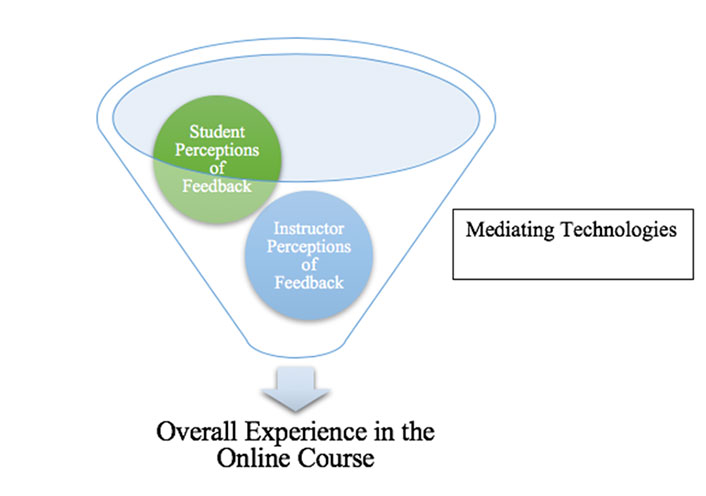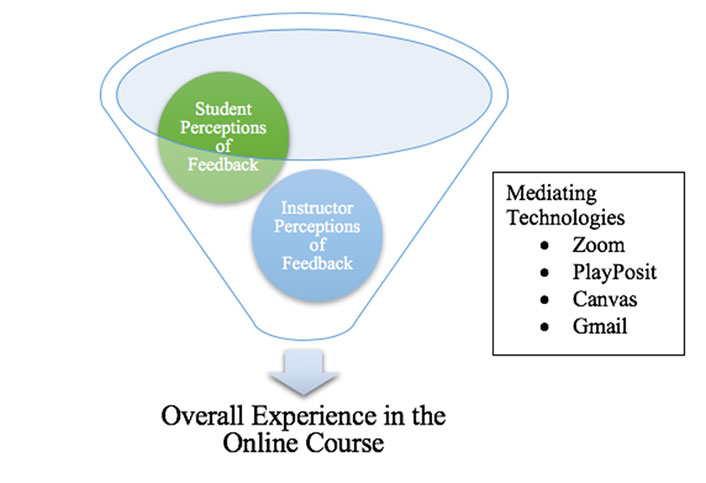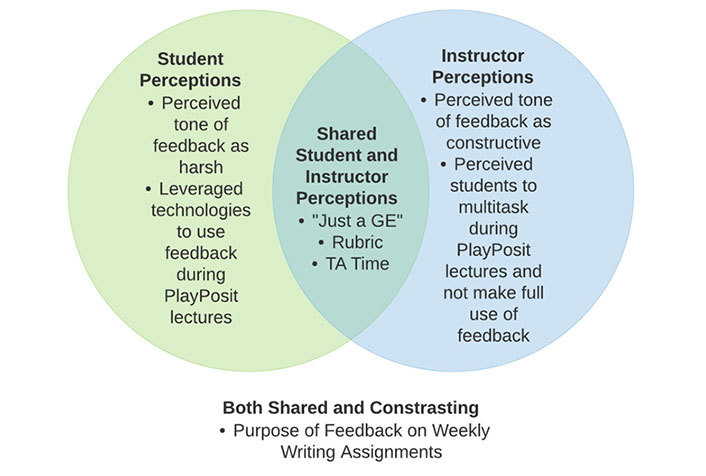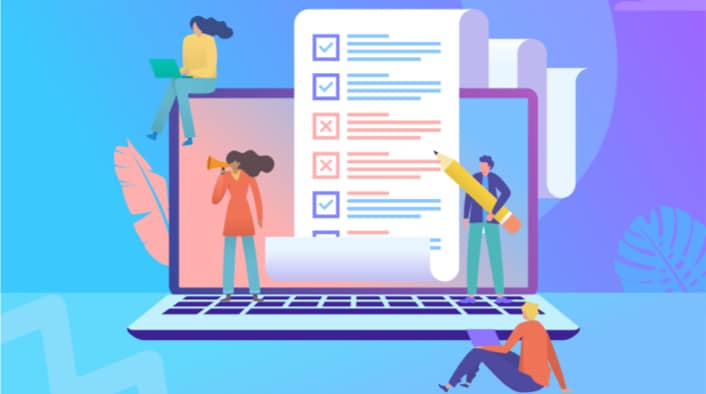Undergraduate Online STEM Course
Using integrated technologies in online courses to provide effective and meaningful feedback to students can leverage the unique affordances of online courses to support student success.
A high-quality online course that mitigates the inherent constraints and leverages the affordances of the online environment cannot be built overnight. However, in times of crisis—whether it be snow in the northeast or fires in the west—educators and students alike are frequently asked to just continue learning online. With remote teaching being used in emergency situations, proactively knowing how to teach and learn online is more important than ever. Educators at all levels need to have a sense of empirically based pedagogy to guide them when they are called to teach online.
Whereas college and university educators are sometimes asked to continue teaching remotely due to regional campus closures caused by blizzards, hurricanes, or fires, educators across the world were tasked with quickly switching to online teaching due to the global pandemic in the spring of 2020. On March 11, 2020, the World Health Organization designated the novel Coronavirus-2019 as a pandemic. In the days following this announcement, private corporations and institutions worked to mitigate the spread of this disease through the implementation of remote work and remote learning. Within a week, higher education and K–12 schools across the country announced the cancellation of in-person classes. By March 19, forty-one states decided to close schools, and 43.9 million students across the United States were no longer attending school in-person.1 In-person classes were to be replaced with online learning. For colleges, universities, and K–12 schools alike, instructors had a week at best to begin moving student learning online.
Feedback in Online Courses: Leveraging Affordances
In my role as an instructional designer at a four-year university and a community college, I found myself and my team faced with helping instructors rapidly move both their final exams and their spring courses online. Across these two dimensions, we faced myriad obstacles for both instructors and students as they moved to teaching and learning remotely. For instructors, these obstacles included moving a course to a learning management system (LMS) for the first time, using unfamiliar technology to deliver synchronous remote lectures, or redesigning in-person labs for online contexts. The obstacles that students faced were heartbreaking and raised serious questions about digital inequities. How were students supposed to finish their courses without a computer that had a camera and audio through which they could participate in newly remote class sessions? If students only had a mobile device, how could they complete assignments that required a computer? These questions focused on student access to technology are difficult enough to surmount, yet other questions arose, including, but in no way limited to, how students who were parents could complete their coursework while homeschooling or even just supervising their children who were no longer in school due to K–12 school closures.
Even before this nationwide move to remote learning, approximately one-third of students in higher education were taking at least one online course.2 The prevalence of online education in higher education transforms both what it means to be a student and what it means to be an instructor today. With school closures in the spring of 2020, an overwhelming majority of K–20 students in the United States experienced remote learning in some form, and these experiences varied greatly. Some students completed distance learning packets distributed by their school district. Others participated in asynchronous learning experiences through technologies such as Flipgrid, Google Classroom, or recorded PowerPoint video lectures, and still others participated in synchronous learning experiences through technologies such as Zoom. Scholars in the field of online education raised the call to be careful not to call this emergency move to remote teaching “online education,” as students and instructors alike should know that these learning experiences were not typical of online education. Scholars expressed concern that online education could get a bad name because quality online courses take purposeful and often time-intensive design.
As online learning environments prompt a move toward student-centered approaches in which the instructor becomes a guide, integrating effective feedback practices is fundamental in supporting a shift from instructor as giver of knowledge to a model in which the instructor is a coach. Results from a multiyear study in 2017 and 2018 on feedback in a high-enrollment online STEM course, Brewing Science, suggests that commonly perceived constraints of online courses can be reimagined as unique affordances.
Ecology of Feedback
To understand feedback in Brewing Science, this study applied an ecology of feedback model to holistically account for student and instructor perceptions of feedback, as well as the mediating technologies through which feedback is provided in an online course. Figure 1 illustrates an ecology of feedback.

Attending to perceptions is essential to understanding the efficacy of feedback because perceptions impact how students use feedback.3 In an ecology of feedback, student and instructor perceptions are impacted by the technologies through which feedback is provided. For this reason, in figure 1, mediating technologies represent the funnel. Feedback in online courses is always mediated by technologies, and this centrality of technologies on the student and instructor experience contributes to the overall experience in an online course.
Feedback in Brewing Science
To contribute to empirically based pedagogy on feedback in online courses, this study explored the ecology of feedback in a large online STEM course with weekly writing assignments by analyzing the technologies through which feedback was provided, as well as student and instructor perceptions of feedback. In terms of technologies, findings show that in this course, students received synchronous and asynchronous feedback via a wide variety of technologies. This feedback at times was provided by the instructor and at other times was automated (see figure 2).

Figure 2 illustrates the wide variety of technologies that were used to deliver feedback, including Zoom, PlayPosit, Canvas, and Gmail, and these technologies impacted both the student and the instructor perceptions of feedback, as well as the overall experience in the online course. The range of technologies used in this course to provide automated and instructor feedback impacted both how students accessed and used feedback, as well as how instructors gave feedback. Different instructors used the technologies differently to provide varying types and forms of feedback, and students accessed and used the feedback in various ways.
One type of feedback consisted of responses students received from their instructors on weekly writing assignments. This feedback was important because it was the only planned opportunity for feedback from an instructor throughout the quarter. As such, this feedback greatly contributed to students’ overall experience in Brewing Science. Using an adapted analysis model to categorize the pragmatic type, linguistic form, and interface features of comments, I found that although the technologies did not vary across and within quarters, the feedback instructors gave varied in important ways across and within quarters.4
First, despite using the same tools, TAs varied in their feedback practices. For example, only one TA gave in-text comments despite the availability of this feature in SpeedGrader in Canvas. Second, feedback decreased as the quarter progressed. Finally, a rubric was used to give feedback primarily in the first quarter and then was abandoned. Instructor feedback on students’ weekly writing assignments varied across quarters, across TAs, across points in the quarter, and between in-text and summative comments. A central component of an ecology of feedback model is time, and without attention to how feedback varied across time, many of these important variations in feedback practice would be missed.
Student and Instructor Perceptions of Feedback
After analyzing technologies that mediated the type of feedback students received, as well as establishing an understanding of how feedback varied across and within the quarter, it was necessary to consider how students and instructors perceived this feedback. Among students, a complicated relationship emerged between feedback and interaction, and these perceptions changed over the quarter. In terms of feedback, at the beginning of the term, students either expected to receive plenty of feedback or were unsure about the feedback they would receive. By the end of the quarter, students largely thought they had received sufficient feedback—or at least as much as they would have received in a face-to-face course. In contrast, student perceptions of interaction varied greatly across and within quarters. At the beginning of the quarter, similar to their expectations about feedback, students either expected interactions with their instructor or were unsure about the interactions they would have with the instructor. However, by the end of each quarter, students expressed varying perspectives of interactions with their instructor.
This complicated picture of the relationship between interaction and feedback supports the idea that students are taking online courses to fit into their busy schedules and that simply adding interaction can actually be a barrier for student completion. Interaction needs to serve the students’ purpose, and feedback can help accomplish this—it can provide meaningful interaction that helps students achieve their goal of doing well in the course. Attrition in online courses is a “complicated phenomenon.”5 One study illuminates the complex relationship between interaction and feedback as it relates to retention in online courses.6 For the students in that research, valuable interaction was more than the instructor responding quickly to questions. They saw quality interactions as those that include “ways in which online students can improve their performance and, therefore, increase their knowledge.” In other words, feedback that promotes student success in the course and overall learning can support quality interactions between instructors and students.
To ensure that feedback can prompt meaningful interactions between instructors and students, the feedback must be effective. Understanding gaps between instructor and student perceptions of feedback can prompt instructor reflection and could ultimately have the greatest impact on pedagogy and feedback practices. Figure 3 compares student and instructor perceptions of feedback in Brewing Science.

These shared, contrasting, and ambiguous perspectives of feedback highlight some unique affordances of online courses. First, the value that students place on TA time helped balance student dissatisfaction with the tone of the feedback they received. Second, students—perhaps emboldened by the increased distance between instructors and students in online courses—felt comfortable reaching out to instructors to express negative reactions to the tone of the feedback they received. Finally, students valued the feedback they received in the PlayPosit video lectures and employed strategies typical in a face-to-face lecture—as well as strategies unique to an online course—to make the most of this feedback. TA time, increased distance between instructors and students, and student control over their viewing of video lectures could be considered constraints of online courses. This study demonstrates that from the student and instructor perspective, these potential constraints can be reframed into affordances that can create an environment that is personalized to student needs as learners.
Reimagining Perceived Constraints as Affordances
While researchers have historically sought ways in which online courses could be equivalent to face-to-face courses, this study found affordances related to feedback unique to online courses. Though increased distance between students and instructors has long been regarded as a constraint of online courses, students in Brewing Science appeared to have just enough distance to challenge and work through miscommunications about feedback with their instructor. Though these miscommunications were not always resolved, the online course provided students enough distance to feel comfortable expressing their reactions to feedback they received from the instructor. Another unique affordance of feedback in this course related to the automated feedback students received on their responses to the embedded quiz questions in prerecorded video lectures. Though instructors expressed concern that students were multitasking while watching the lectures or were watching the lectures at double speed, students generally found the feedback provided during these lectures to be extremely valuable. Students leveraged the feedback they received in these lectures in ways that supported their learning and that the instructors did not predict. The unique affordances of feedback in this online course encouraged meaningful interactions for students with their instructors and with the content of the course.
Implications for the Field of Online Education
Even before recent global moves to remote teaching due to the pandemic, online education was a continually growing sector of higher education at a time when enrollments in traditional higher education institutions are declining. A majority of academic leaders in higher education institutions see online education as crucial for an institution’s long-term success.7 At this moment, public institutions are integrating online education to provide students opportunities to enroll in online courses (e.g., Brewing Science), online programs (e.g., Oregon State University Ecampus), and online colleges (e.g., Calbright College, an online California community college). These moves toward online education are important because now, more than ever, in order to achieve living wages and meaningful work, 21st-century employees need a college degree—since the recession, 97% of “good jobs” have gone to college graduates.8
However, the barriers that students face today are enormous. The so-called “traditional” college student who lives on campus, takes courses full time, and graduates in four-years is no longer the majority student, even at four-year residential institutions.9 Instead, a typical student today has responsibilities that include some (if not all) of the following:
- Parenting young children and/or taking care of siblings or relatives
- Working a full-time job or multiple jobs
- Commuting to campus
Students in the Brewing Science course represented these larger trends—they were parenting young children, working, busy with demanding academic schedules, and commuting sometimes one (or two hours, depending on traffic) to campus. One case study student was graduating during one year of the study and found that the flexibility of the online course allowed her to better navigate the unforeseen complications that can arise as a caregiver. For students with such demands on their time, online courses can provide high-quality educational opportunities that can be accessed on the student’s schedule.
Online courses clearly have the potential to provide high-quality educational opportunities to all students, despite the many family, personal, work, and academic obligations they face. However, the students who are uniquely situated to best be served by online education continue to be left behind.10 Although the field of distance education can be dated back to the mid-1800s, there continues to be a lack of empirically based pedagogy to inform instruction in online courses. This means that students are more often taking online courses that are simply copied and pasted versions of face-to-face courses. But this approach cannot mitigate or leverage the unique constraints and affordances of online courses and the associated centralized technologies.
Applying the ecology of feedback model addresses this larger concern about online education and the lack of empirically based pedagogy through the exploration of feedback with attention to mediating technologies. Feedback is a crucial component of effective pedagogy. Effective feedback can “empower students as self-regulated learners.”11 On the flip side, ineffective feedback can function as an additional barrier to students as they work to try to interpret or apply confusing or abundant but ineffectual feedback.
Conclusion
In an online course, the impact of feedback can be heightened in that it is often the only interaction between instructors and students. In Brewing Science, student perceptions of feedback were relatively consistent, both before and at the end of the quarter, but student perceptions of interaction varied. Some research has shown that instructor-student interactions can encourage satisfaction and success of the overall course; however, other research shows that more interaction in online courses actually decreased course completion rates.12 Instructor-student interactions that mirror the synchronous nature of interactions in face-to-face courses do not leverage the integrated technologies in online courses that could incorporate meaningful asynchronous instructor-student interactions. These asynchronous interactions could support students who are poised to gain the most from high-quality online courses due to family, work, personal, and professional obligations that make success in a typical face-to-face course particularly challenging. Feedback is a meaningful way to incorporate instructor-student interactions in ways that transcend demands on student time and can help establish meaningful interactions to fulfill the potential of online courses to increase student access and success in higher education.
Notes
- “Map: Coronavirus and School Closures,” Education Week, March 6, 2020. ↩
- Julia E. Seaman, I. Elaine Allen, and Jeff Seaman, Grade Increase: Tracking Distance Education in the United States, Babson Survey Research Group, 2018. ↩
- Phil Ice, Karen Swan, Sebastian Diaz, Lori Kupczynski, and Allison Swan-Dagen, “An Analysis of Students’ Perceptions of the Value and Efficacy of Instructors’ Auditory and Text-Based Feedback Modalities across Multiple Conceptual Levels,” Journal of Educational Computing Research 43, no. 1 (July 2010): 113–34. ↩
- Dana R. Ferris, Susan Pezone, Cathy R. Tade, and Sharee Tinti, “Teacher Commentary on Student Writing: Descriptions & Implications,” Journal of Second Language Writing 6, no. 2 (May 1997): 155–82. ↩
- Pedro A. Willging and Scott D. Johnson, “Factors that Influence Students’ Decision to Dropout of Online Courses,” Journal of Asynchronous Learning Networks 13, no. 3 (October 2009): 115–27. ↩
- Jorge Gaytan, “Comparing Faculty and Student Perceptions Regarding Factors That Affect Student Retention in Online Education,” American Journal of Distance Education 29, no. 1 (March 11, 2015): 56–66. ↩
- I. Elaine Allen and Jeff Seaman, Online Report Card: Tracking Online Education in the United States, Babson Survey Research Group, February 2016. ↩
- Anthony P. Carnevale, Tamara Jayasundera, and Artem Gulish, Good Jobs Are Back: College Graduates Are First in Line, Georgetown University Center on Education and the Workforce, 2015. ↩
- David L. Clinefelter and Carol B. Aslanian, Online College Students 2012: Comprehensive Data on Demands and Preferences, The Learning House, Inc., July 2015. ↩
- Sandy Baum and Michael McPherson, “The Human Factor: The Promise & Limits of Online Education,” Daedalus 148, no. 4 (Fall 2019): 235–54. ↩
- David J. Nicol and Debra Macfarlane‐Dick, “Formative Assessment and Self‐Regulated Learning: A Model and Seven Principles of Good Feedback Practice,” Studies in Higher Education 31 no. 2 (January 24, 2007): 199–218. ↩
- Swan, “Virtual Interaction,” 2006; Christian J. Grandzol and John R. Grandzol, “Interaction in Online Courses: More Is NOT Always Better,” Online Journal of Distance Learning Administration 13, no. 2 (Summer 2010). ↩
Alex Rockey is an Instructional Technology Instructor at Bakersfield College.

